 Multiple Choice Questions
Multiple Choice QuestionsThe angular amplitude of a simple pendulum is θ0. The maximum tension in its string will be
mg (1 - θ0)
mg (1 + θ0 )
D.
The simple pendulum at angular amplitude θo is shown in the figure
Tmax = ....(i)
When bob of pendulum comes from A to B, it covers a vertical distance h.

∴
⇒ h = l ( l - cos θ ) .....(ii)
Also during A to B, potential energy of bob converts into kinetic energy
∴ mgh =
∴ v = ....... (iii)
Thus, using Eqs. (i), (ii) and (iii) we obtain
Tmax = mg +
= mg + 2mg
(By using binomial theorem)
= mg
A particle is subjected to two simple harmonic motions along X-axis while other is along a line making angle 45° with the X-axis. The two motions are given by x = x0 sin ωt and s =s0 sin ωt. The amplitude of resultant motion is
x0 + s0 + 2x0s0
A pan with a set of weights is attached to a light spring. The period of vertical oscillation is 0.5s. When some additional weights are put in pan, then the period of oscillations increases by 0.1 s. The extension caused by the additional weight is
5.5 cm
3.8 cm
2.7 cm
1.3 cm
A particle is describing simple harmonic motion. If its velocities are v1 and v2 when the displacements from the mean position are y1 and y2 respectively, then its time period is
Assertion: A particle in x-y plane is related by x = sin t and y = (l - cos t), where and ω are constants, then the particle will have parabolic motion.
Reason: A particle under the influence of two perpendicular velocities has parabolic motion.
If both assertion and reason are true and reason is the correct explanation of assertion.
If both assertion and reason are true but reason is not the correct explanation of assertion.
If assertion is true but reason is false.
If both assertion and reason are false.
A body of mass 60 kg is suspended by means of three strings P Q and R as shown in the figure is in equilibrium. The tension in the string P is

130.9 g N
60 g N
50 g N
103.9 g N
The angular amplitude of simple pendulum is θo. The maximum tension in its string will be
mg ( 1 - θ0 )
mg ( 1 + cosθ0)
mg ( 1 - cos![]() )
)
mg ( 1 + cos![]() )
)
The displacement of a particle executing SHM is given by y = 0.25 sin200t cm. The maximum speed of the particle is
200 cm s-1
100 cm s-1
50 cm s-1
5.25 cm s-1
A mass M is suspended from a spring of negligible mass. The spring is pulled a little and then released so that the mass executes simple harmonic oscillations with a time period T. If the mass is increased by m, then the time period becomes . The ratio of is
9/16
5/4
25/16
4/5
A wave is represented by the equation y= 0.5 sin(10t x) metre It is a travelling wave propagating along +x direction with velocity
10 m s-1
20 m s-1
5 m s-1
None of these
